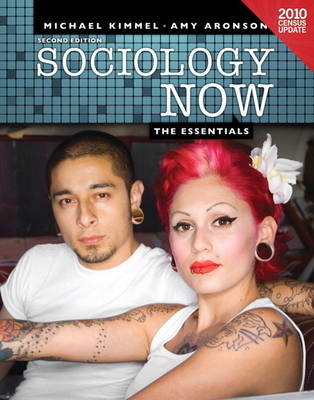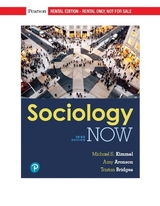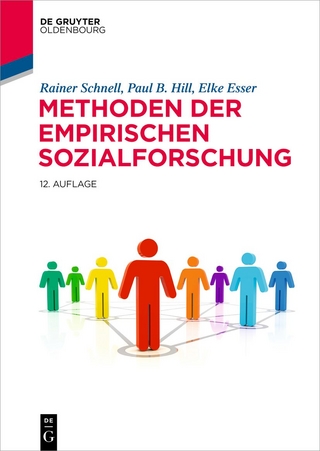
Sociology Now
Pearson (Verlag)
978-0-205-18105-6 (ISBN)
- Titel erscheint in neuer Auflage
- Artikel merken
Sociology Now reflects the discipline today and explores the big questions about multiculturalism and globalization that sociologists ask.
It explains how the classic concerns of sociology—social order, social conflict, social interaction—have been reshaped by new insights about multiculturalism and globalization.
Sociology has always offered a way to make sense of the complex and sometimes contradictory forces that shape our social lives in any era. As Sociology Now explains sociology as both a body of knowledge and a "way of seeing," it shows how the forces of globalization and multiculturalism have come to preoccupy sociologists and influence the way they look at the events and experiences of the early twenty first century. Michael Kimmel, a leading sociologist and gender researcher, and co-author Amy Aronson, a journalist and media scholar, address questions regarding these forces head-on as they make a compelling case for the importance of sociology in the contemporary world.
The Census Update program incorporates 2010 Census data into a course–simply and easily. The components of the Census Update Program include an updated census edition with all charts and graphs–to reflect the results of the 2010 Census. In addition, A Short Introduction to the U.S. Census is available and an updated MySocLab.
Teaching & Learning Experience
Personalize Learning – MySocLab delivers proven results in helping students succeed, provides engaging experiences that personalize learning, and comes from a trusted partner with educational expertise and a deep commitment to helping students and instructors achieve their goals.
Improve Critical Thinking – Each chapter opener asks students to consider a paradox that illustrates the complexity of sociology.
Engage Students – Unique pedagogical features help students see sociology as a science and understand how sociologists use research data.
Explore Theory – Theory is discussed in context of multiculturalism and globalization.
Understand Diversity – Race, class, and gender are discussed both as the foundations of our identity and as sources of inequality.
Support Instructors – The test bank is edited by the authors.
Note: MySocLab does not come automatically packaged with this text. To purchase MySocLab, please visit: www.mysoclab.com or you can purchase a valuepack of the text + MySocLab (at no additional cost). ValuePack ISBN-10: 0205171397 / ValuePack ISBN-13: 9780205171392
Michael S. Kimmel is a Professor of Sociology at SUNY at Stony Brook. He is the author of Guyland: The Perilous World Where Boys Become Men (HarperCollins, 2008) which was featured on the Today Show, Good Morning America and featured on over one hundred radio and newspaper and blog reviews. His other books include Changing Men (1987), Men’s Lives(8th edition, 2009) Against the Tide: Profeminist Men in the United States, 1776-1990 (1992), The Politics of Manhood (1996),Manhood: A Cultural History (1996, 10th anniversary second edition, 2006), and The Gendered Society (3rd edition, 2008). He co-edited The Encyclopedia on Men and Masculinities (2004) and Handbook of Studies on Men and Masculinities (2004). He is the founder and editor of Men and Masculinities, the field’s premier scholarly journal, a book series on Gender and Sexuality at New York University Press, and edited the Sage Series on Men and Masculinities. He lectures extensively in corporations and on campuses in the U.S. and abroad. He lives in Brooklyn, New York with his wife and co-author, Amy Aronson, and their 10 year old son, Zachary. Amy Aronson is Assistant Professor of Journalism and Media Studies at Fordham University. She is the author of Taking Liberties: Early American Women's Magazines and Their Readers and an editor of the international quarterly, Media History. She has co-edited several books, including a centennial edition of Charlotte Perkins Gilman's Women and Economics and the two-volume Encyclopedia of Men and Masculinities, which was honored by the New York Public Library with a Best of Reference Award in 2004. A former editor at Working Woman and Ms., her work has also appeared in publications including Business Week, Global Journalist and the Sunday supplement of The Boston Globe.
IN THIS SECTION:
1.) BRIEF
2.) COMPREHENSIVE
BRIEF TABLE OF CONTENTS:
Chapter 1: What Is Sociology?
Chapter 2: Culture and Society
Chapter 3: Society: Interactions, Groups, And Organizations
Chapter 4: How Do We Know What We Know? The Methods Of The Sociologist
Chapter 5: Socialization
Chapter 6: Deviance and Crime
Chapter 7: Stratification and Social Class
Chapter 8: Race and Ethnicity
Chapter 9: Sex and Gender
Chapter 10: The "Sociological Body": Age, Health, and Sexuality
Chapter 11: The Family
Chapter 12: Economy and Work
Chapter 13: Politics and Media
Chapter 14: Education, Religion, and Science
Chapter 15: Sociology Of Environments: The Natural, Physical, and Human Worlds
COMPREHENSIVE TABLE OF CONTENTS:
Chapter 1: What is Sociology?
Sociology as a Way of Seeing
Doing Sociology
Where Did Sociology Come From?
Contemporary Sociology
Sociology in the 21st Century, Sociology and You
Chapter 2: Culture and Society
Culture
Elements of Culture
Cultural Expressions
Cultural Change
Culture in the 21st Century
Chapter 3: Society: Interactions, Groups, and Organizations
Society: Putting Things in Context
The Social Construction of Reality
Elements of Social Structure
Groups
Social Networks
Organizations
Groups ‘R’ Us: Groups and Interactions in the 21st Century
Chapter 4: How Do We Know What We Know? The Methods of the Sociologist
Why Sociological Methods Matter
Types of Sociological Research Methods
Social Science and the Problem of “Truth”
Doing Sociological Research
Issues in Conducting Research
Social Science Methods in the 21st Century: Emergent Methodologies
Chapter 5: Socialization
Socialization and Biology
Socialization in Action
Models of Socialization
Agents of Socialization
Socialization and the Life Course
Socialization in the 21st Century
Chapter 6: Deviance and Crime
What Is Deviance?
Conformity and Social Control
Deviance and Social Coherence
Sociological Theories of Deviance and Crime
Types of Crimes
Crime in the United States
The Criminal Justice System
Globalization and Crime
Deviance and Crime in the 21st Century
Chapter 7: Stratification and Social Class
What Is Social Stratification?
Social Class
Poverty in the United States and Abroad
Social Mobility
Global Inequality
Class Identity and Class Inequality in the 21st Century
Chapter 8: Race and Ethnicity
The Sociology of Race and Ethnicity
Prejudice, Discrimination, and Racism
Ethnic Groups in the United States
Ethnicity, Identity, and Conflict
Race and Ethnicity in the 21st Century
Chapter 9: Sex and Gender
Sex and Gender: Nature and Nurture
Becoming Gendered: Learning Gender Identity
Gender Inequality on a Global and Local Scale
Gender Inequality in the United States
The Politics of Gender
Gender Inequality in the 21st Century
Chapter 10: The "Sociological Bosdy:" Age, Health, and Sexuality
The Social Body
Age: Identity and Inequality
Youth and Inequality
The Body in Sickness and Health
Studying Sexuality: Behaviors and Identities
American Sexual Behavior and Identities
Sexual Inequality
Age and Sexuality in the 21st Century
Chapter 11: The Family
The Family Tree
Family and Ethnicity
Forming Families
Parenting
Family Transitions
Violence in Families
The Family in the 21st Century: “The Same as It Ever Was”
Chapter 12: Economy and Work
The Economy and Society
The American Economy
Work, Identity, and Inequality
Diversity in the Workplace
Work and Economy in the 21st Century
Chapter 13: Politics and Media
Politics: Power and Authority
Political Systems
The Political System of the United States
Political Change
What Are the Mass Media
Media Production and Consumption
Globalization of the Media
Politics and Media in the 21st Century
Chapter 14: Education, Religion, and Science
Education in Social Context
The Sociology of Education
Religion and Science
Religion, Globally and Locally
Science in Sociological Perspective
Education, Religion, and Science in the 21st Century
Chapter 15: Sociology of Environments: The Natural, Physical, and Human Worlds
The Human Environment
Theories of Global Population Growth
The Urban Environment
Sociology and the City
The Natural Environment
Environments in the 21st Century
| Erscheint lt. Verlag | 14.12.2011 |
|---|---|
| Sprache | englisch |
| Maße | 213 x 272 mm |
| Gewicht | 1020 g |
| Themenwelt | Sozialwissenschaften ► Soziologie ► Empirische Sozialforschung |
| ISBN-10 | 0-205-18105-8 / 0205181058 |
| ISBN-13 | 978-0-205-18105-6 / 9780205181056 |
| Zustand | Neuware |
| Informationen gemäß Produktsicherheitsverordnung (GPSR) | |
| Haben Sie eine Frage zum Produkt? |
aus dem Bereich



